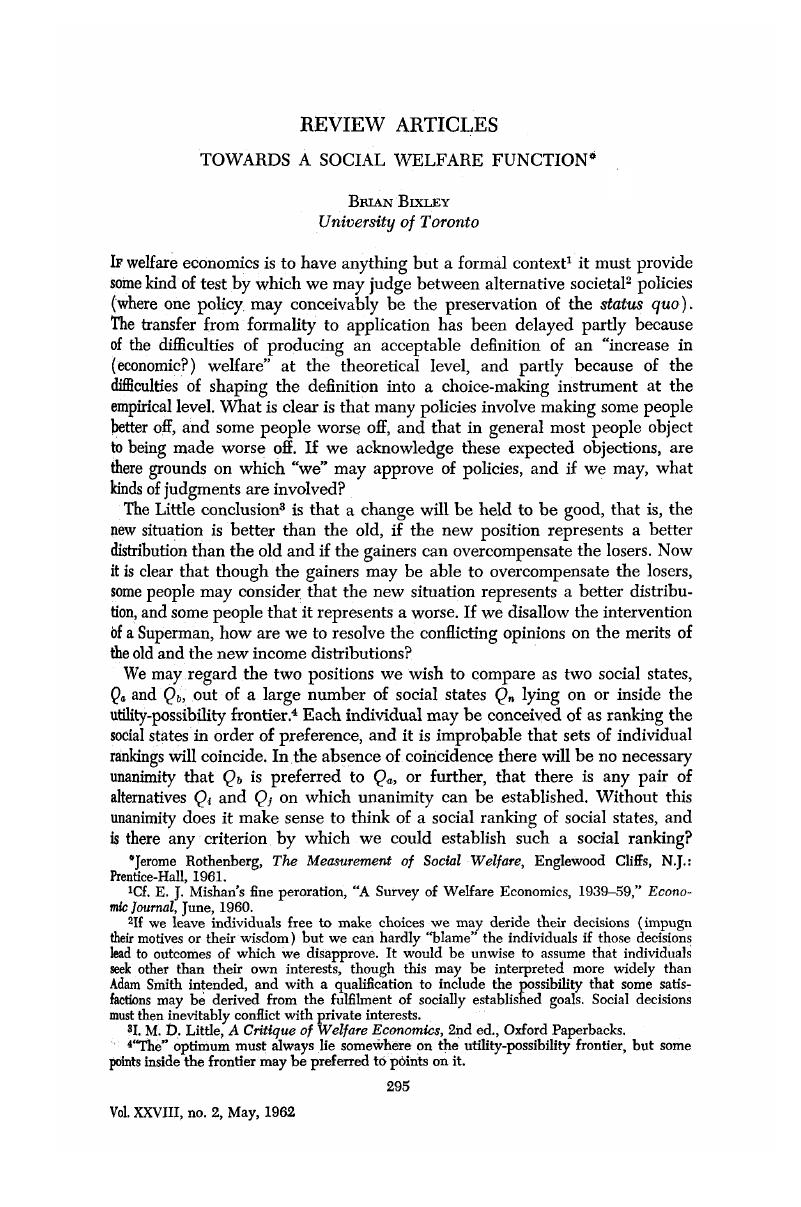No CrossRef data available.
Article contents
Towards a Social Welfare Function*
Published online by Cambridge University Press: 07 November 2014
Abstract

- Type
- Review Article
- Information
- Canadian Journal of Economics and Political Science/Revue canadienne de economiques et science politique , Volume 28 , Issue 2 , May 1962 , pp. 295 - 300
- Copyright
- Copyright © Canadian Political Science Association 1962
Footnotes
Jerome Rothenberg, The Measurement of Social Welfare, Englewood Cliffs, N.J.: Prentice-Hall, 1961.
References
1 Cf. Mishan's, E. J. fine peroration, “A Survey of Welfare Economics, 1939–59,” Economic Journal, 06, 1960.Google Scholar
2 If we leave individuals free to make choices we may deride their decisions (impugn their motives or their wisdom) but we can hardly “blame” the individuals if those decisions lead to outcomes of which we disapprove. It would be unwise to assume that individuals seek other than their own interests, though this may be interpreted more widely than Adam Smith intended, and with a qualification to include the possibility that some satisfactions may be derived from the fulfilment of socially established goals. Social decisions must then inevitably conflict with private interests.
3 Little, I. M. D., A Critique of Welfare Economics, 2nd ed., Oxford Paperbacks.CrossRefGoogle Scholar
4 “The” optimum must always lie somewhere on the utility-possibility frontier, but some points inside the frontier may be preferred to pdirits on it.
5 Preface, Critique of Welfare Economics.
6 Clearly, in principle, all individuals. In practice, as Rothenberg notes, we may already be faced with group rankings, as in family decisions, but this implies that the intra-family weighting problems have been resolved one way or another.
7 It is only fair to add that I have passed up comment on the larger portion of the book to concentrate on the central thesis. I thus omit any discussion of the acute survey of the welfare and utility literatures.
8 My translation. It is very strange that Rothenberg makes no reference to Tinbergen, Theil, or Frisch (except a 1932 reference) or to the work at the Netherlands School of Economics, the Netherlands Central Planning Bureau, and the Oslo Institute of Economics.
9 Rothenberg points out justifiably that his book is in principle concerned with “meta-welfare economics, for it examines the foundations of public policy in general. The policy alternatives dealt with by no means need to be ‘economic policies.’” (7) It becomes more difficult to interpret the α−1β matrix in this light, but no more so than the interpretation of “the foundations of public policy in general.”
10 See Measurement of Social Welfare, 42.
11 Really the game is a continuing one, with outcomes at discrete time intervals.
12 This may have sometimes to be an ex post expression. Few finance ministers will be willing to announce to the world a decision to devalue.




